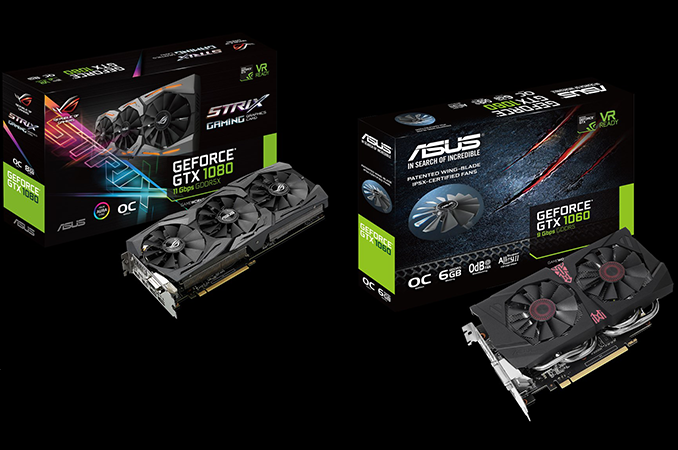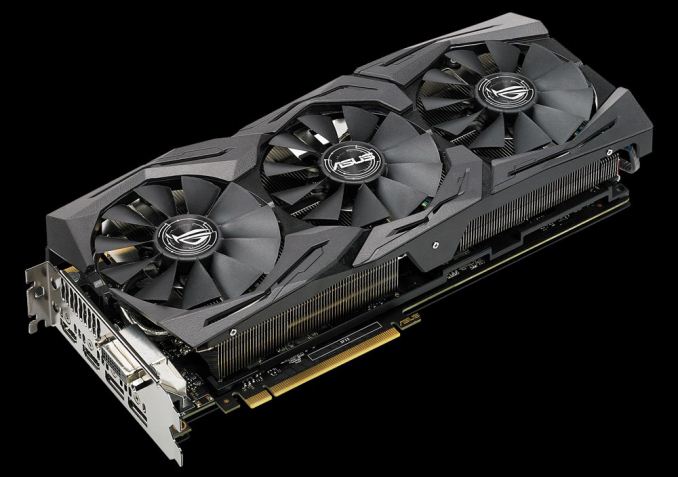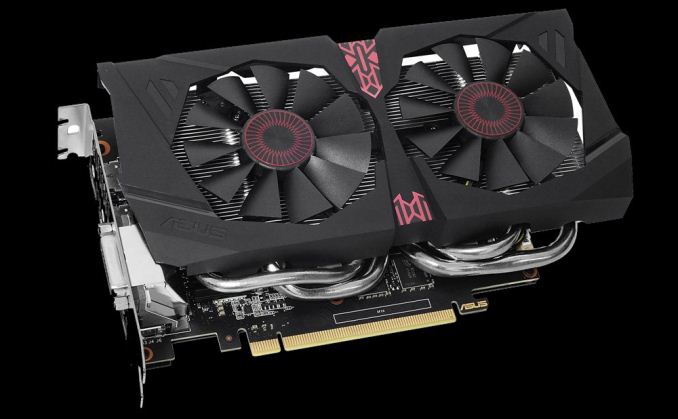ASUS Launches GeForce GTX 1080 & GTX 1060 Models With Faster RAM
by Anton Shilov on April 11, 2017 2:00 PM EST
ASUS has released graphics cards based on NVIDIA’s GeForce GTX 1060 and 1080 GPUs that are equipped with faster memory. The new add-in-boards (AIBs) are designed to offer greater performance in high resolutions than reference designs and enable ASUS to charge a premium for the higher FPS.
Back in February when NVIDIA cut the price on the GTX 1080, the company also announced that they would be working with partners to sell factory overclocked cards with higher speed grades of memory. At launch the fastest grades available for the GTX 1080 and GTX 1060 were 10Gbps GDDR5X and 8Gbps GDDR5 respectively; however in the last year, 11Gbps GDDR5X and 9Gbps GDDR5 have become available. Now those faster memory grades are being made available to their partners for use in factory overclocked cards, giving partners more configuration options for their factory overclocked SKUs.
For partners, this marks their first real opportunity to sell cards with memory overclocks. While NVIDIA’s GPUs have been able to support these higher speeds, the stock configurations for the GTX 1080 and GTX 1060 were already pushing their respective RAM types to their limit, leaving partners no real headroom for the kind of stable and consistent overclocks required for factory overclocking.
At a hardware level, things are pretty straightforward for GTX 1080 cards; vendors can now grab Micron’s 11Gbps GDDR5X chips and use them in the place of 10Gbps chips. Things are a bit less clear on the source of the GDDR5 however. The only manufacturer with an official 9Gbps part listed is Samsung, whose K4G41325FE is still at the "Customer Sample" phase. More importantly however, that chip is only offered in a 4Gb density, whereas NVIDIA has used 8Gb chips for both the GTX 1080 and GTX 1060 6GB. So it will be interesting to see just how 9Gbps GTX 1060s are equipped.
Now, back to ASUS’ GeForce GTX 10 cards with faster memory. At present, the company offers two of such boards: the ROG Strix GeForce GTX 1080 OC Edition 8 GB 11 Gbps as well as the ASUS GeForce GTX 1060 OC Edition 6 GB 9 Gbps. The two AIBs belong to different classes of products, but in both cases ASUS did something more than just soldered faster memory chips to PCBs.
The ASUS ROG Strix GeForce GTX 1080 OC Edition 11 Gbps GDDR5X is based on the company’s proprietary PCB design with an 8+2 phase VRM, one 6-pin and one 8-pin PCIe power connectors. The enhanced power supply circuitry and an additional power connector enable ASUS to increase GPU and memory frequencies from those recommended by NVIDIA and ensure some additional headroom for end-user overclocking. Meanwhile, ASUS does not disclose exact GPU clock rates of its flagship GeForce GTX 1080, which means that the company is still finalizing them.
To ensure proper cooling of the GPU, VRM and memory, ASUS equips its ROG Strix GeForce GTX 1080 OC Edition 11 Gbps with a 2.5-wide cooling system featuring six heat pipes and three fans (which stop rotating at low GPU temperatures). As an added bonus, the cooler features ASUS’ user-controllable Aura Sync RGB lighting.
The ASUS GeForce GTX 1060 OC Edition 6 GB 9 Gbps also uses ASUS’ own PCB as well as the company’s DirectCU II cooling system with four heatpipes and two fans. Obviously, since this is an OC Edition AIB, its GPU frequency is higher than that on reference cards, but ASUS does not publish it. The card does not belong to the ROG or the Strix families, it is not the top-of-the-range GeForce GTX 1060 from ASUS, so expect company to offer something faster based on the GP106 GPU over time.
| Specifications of ASUS GeForce GTX 1080 11 Gbps and GTX 1060 9 Gbps | ||||||||
| ASUS ROG Strix GeForce GTX 1080 OC Edition 11 Gbps |
NVIDIA GeForce GTX 1080 Founders Edition |
ASUS GeForce GTX 1060 OC Edition 9 Gbps |
NVIDIA GeForce GTX 1060 Founders Edition |
|||||
| Stream Processors | 2560 | 1280 | ||||||
| Texture Units | 160 | 80 | ||||||
| ROPs | 64 | 48 | ||||||
| Core Clock (MHz) | 1670 - 1695 (?) | 1607 | 1506 - 1531 (?) | 1506 | ||||
| Boost Clock (MHz) | 1809 - 1835 (?) | 1733 | 1708 - 1746 (?) | 1708 | ||||
| Memory | Capacity | 8 GB | 6 GB | |||||
| Type | GDDR5X | GDDR5 | ||||||
| Clock | 11 Gbps | 10 Gbps | 9 Gbps | 8 Gbps | ||||
| Power | 1×8-pin PCIe 1×6-pin PCIe >180 W |
1×8-pin PCIe 180 W |
1×6-pin PCIe ~150 W |
150 W | ||||
| VRM | 8+2 phases | 5+1 phases | ? | 3+1 phases | ||||
| PN, Additional Details | ROG-STRIX-GTX1080-O8G-11GBPS | - | GTX1060-O6G-9GBPS | - | ||||
| Launch Date | Q2-2017 | 5/2016 | Q2-2017 | 8/2016 | ||||
| Launch Price | ? | $699 | ? | $449 | ||||
ASUS has not announced MSRPs for its GeForce GTX 1080 11 Gbps and GeForce GTX 1060 6 GB 9 Gbps products, but since they are listed on its website, they are going to show up on shelves soon and thus prices will be revealed. As usual, bear in mind that prices will vary depending on the region.
Related Reading:
- ASUS Demonstrates ROG Swift PG27UQ: 4K, 144 Hz, HDR, DCI-P3 and G-Sync
- GeForce GTX 1080 Price Cut to $499; NVIDIA Partners To Begin Selling 10-Series Cards With Faster Memory
- The NVIDIA GeForce GTX 1080 Ti Founder's Edition Review: Bigger Pascal for Better Performance
- NVIDIA Announces NVIDIA Titan Xp Video Card: Fully Enabled GP102 for $1200
Source: ASUS

























20 Comments
View All Comments
Flunk - Tuesday, April 11, 2017 - link
I predict this will make no noticeable difference at all.lazarpandar - Tuesday, April 11, 2017 - link
For machine learning it should make a small difference.extide - Tuesday, April 11, 2017 - link
It would be nice to see an RX480 with 9Gbps ram as it seems to be pretty memory bottlenecked.ImSpartacus - Tuesday, April 11, 2017 - link
Yeah, and yet, all rumors point to the same old 8Gbps stuff in the 580...Samus - Wednesday, April 12, 2017 - link
AMD cards always seem to be memory limited. Some of their older cards had 512-bit buses I think and it was just ridiculous how much overclocking memory helped then. And the irony is historically, AMD cards have shipped with more memory. Most of their mid range were hovering around 4GB when nvidia was still at 1.5GB.Yojimbo - Tuesday, April 11, 2017 - link
NVIDIA can probably increase their clock speeds from what they launched at, as well. Their board partners will probably launch cards with more aggressive clocks to go along with the faster memory. So there will probably be a small but significant increase in performance, perhaps something coming close to what AMD achieves with their 500 series Polaris rebrands.MrSpadge - Tuesday, April 11, 2017 - link
10% more bandwidth can result in 10% more performance, at best. that by itself is not noticeable, but if the price premium is at most 10%, it's a perfectly valid alternative to the current cards.Diji1 - Wednesday, April 12, 2017 - link
Ten percent performance is noticeable in some situations.Meteor2 - Wednesday, April 12, 2017 - link
I would say most.bcronce - Wednesday, April 12, 2017 - link
For the Pascal line-up, a 10% increase in memory speed resulted in about a 1% increase in performance. A 10% reduction in memory speed resulted in about a 1% reduction in performance.I actually underclock my memory because a 10% reduction in frequency = 10% reduction in power and heat.
On the other hand, a 10% increase in GPU frequency results in about an 8% increase in performance. Totally worth it.